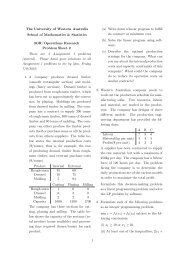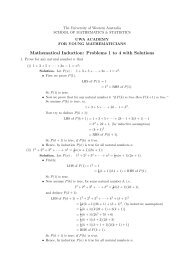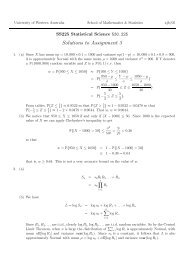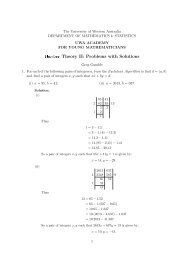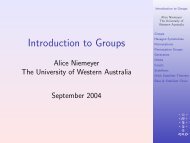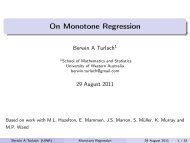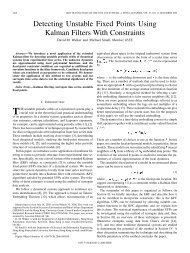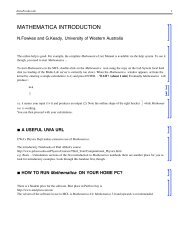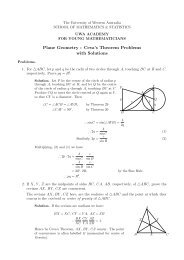Rank 3 permutation groups
Rank 3 permutation groups
Rank 3 permutation groups
Create successful ePaper yourself
Turn your PDF publications into a flip-book with our unique Google optimized e-Paper software.
<strong>Rank</strong> 3 <strong>permutation</strong> <strong>groups</strong>Michael Giudicijoint work with Alice Devillers, Cai Heng Li, Geoffrey Pearceand Cheryl PraegerCentre for the Mathematics of Symmetry and ComputationTwenty-Ninth Annual Victorian Algebra ConferenceDecember 2011
<strong>Rank</strong> of a <strong>permutation</strong> groupG transitive <strong>permutation</strong> group on ΩG also acts on Ω × Ω via(α, β) g = (α g , β g )The rank of G is the number of orbits of G on Ω × Ω.• {(α, α) | α ∈ Ω} is one orbit.• G has rank 2 if and only if {(α, β) | α ≠ β} is an orbit, thatis, if and only if G is 2-transitive.
SuborbitsThere is a one-to-one correspondence between orbits of G α on Ωand orbits of G on Ω × Ω given byβ Gα ←→ (α, β) GHence the rank of G is also the number of orbits of G α on Ω.
Wreath ProductsLet H Sym(∆) and K S k .Define H wr K = H k ⋊ K, where K acts on H k by permutingcoordinates.The group H wr K has two natural actions:• imprimitive action: on ∆ × {1, . . . , k} where(δ, i) (h 1,...,h k )σ = (δ h i, i σ )∆1 2 3 . . . kNote that G permutes the sets ∆ × {i}.
Wreath Products II• product action: on ∆ k , where(δ 1 , . . . , δ k ) (h 1,...,h k ) = (δ h 11 , . . . , δh kk )(δ 1 , . . . , δ k ) σ = (δ 1 σ −1 , . . . , δ k σ−1 )
Systems of imprimitivityA transitive group is called imprimitive if it preserves somenontrivial partition of Ω.Called primitive otherwise.The stabiliser of a partition into b parts of size a in S ab isS a wr S b
Systems of imprimitivity IIG imprimitive with system of imprimitivity B.• G B , the subgroup of Sym(B) induced by G, is transitive.• all blocks in B have the same size• GB B , the subgroup of Sym(B) induced by the setwise stabiliserG B , is transitive;• action of G is isomorphic to a subgroup of G B B wr G B
2-transitive <strong>groups</strong>All 2-transitive <strong>groups</strong> are primitive.Burnside’s Theorem: A 2-transitive group is either:• almost simple, that is T G Aut(T ) with T a nonabeliansimple group, or• a subgroup of AGL(d, p).All finite 2-transitive <strong>groups</strong> were classified as a consequence of theClassification of Finite Simple Groups.
<strong>Rank</strong> 3 <strong>groups</strong>Study goes back to Donald G. Higman in 1964.Some examples:• S n acting on 2-subsets.• PGL n (q) acting on 2-subspaces• Higman-Sims group on 100 points.• S n wr S 2 acting in product action on ∆ 2 , where |∆| = n,• S a wr S b acting imprimitively on ab points.
Primitive rank 3 <strong>groups</strong>All rank 3 primitive <strong>groups</strong> have been classified. They are either• almost simple (Bannai, Kantor-Liebler, Liebeck-Saxl)• a subgroup of AGL(d, p) (Liebeck)• a subgroup of H wr S 2 acting on ∆ 2 , where H is an almostsimple 2-transitive group on ∆
Imprimitive rank 3 <strong>groups</strong>Recall that an imprimitive group G is a subgroup of G B B wr G B .If G has rank 3 then both G B BB is the unique system of imprimitivity.and G B are 2-transitive.Conversely, if H Sym(B) and K S k are both 2-transitive thenH wr K has rank 3.Which sub<strong>groups</strong> of H wr K have rank 3?
A characterisationTheoremSuppose that G is an imprimitive group with• GBB a 2-transitive almost simple group with socle T• G B S k is 2-transitive.Then G has rank 3 if and only if one of the following holds:1 T k G2 G is quasiprimitive and rank 33 k = 2 and G = M 10 , PGL(2, 9) or Aut(A 6 ) acting on 12points;4 k = 2 and G = Aut(M 12 ) acting on 24 points.
Quasiprimitive <strong>groups</strong>A <strong>permutation</strong> group is called quasiprimitive if every nontrivialnormal subgroup is transitive.Every primitive group is quasiprimitive.If G is quasiprimitive and imprimitive then it acts faithfully on anysystem of imprimitivity.
TheoremA quasiprimitive rank 3 group is either primitive or listed in thetable.G k m GB B extra conditionsM 11 11 2 C 2G PSL(2, q) q + 1 2 C 2 q ≡ 1 (mod 4) plusother conditions on GG PSL(a, q)q a −1q−1m AGL(1, m) a ≥ 3, m prime plusother conditionsPGL(3, 4) 21 6 PSL(2, 5)PΓL(3, 4) 21 6 PGL(2, 5)PSL(3, 5) 31 5 S 5PSL(5, 2) 31 8 A 8PΓL(3, 8) 73 28 Ree(3)PSL(3, 2) 7 2 C 2PSL(3, 3) 13 3 S 3



